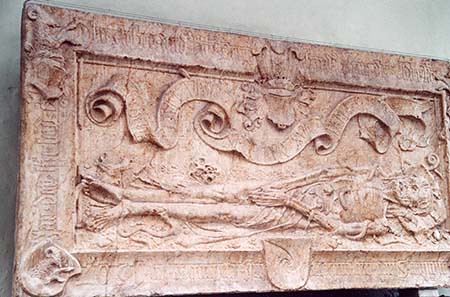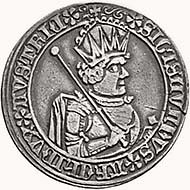
PREV ARTICLE
NEXT ARTICLE
FULL ISSUE
PREV FULL ISSUE
KEY THALER FIGURES: ARCHDUKE SIGISMUND AND BERNHARD BEHEIM
Ursula Kampmann authored two nice articles in the October 11, 2012 issue of CoinsWeekly on the topic of early thaler coinage.
These are only short excerpts. Be sure to read the complete versions online.
-Editor
Ursula Kampmann prefaced the issue with this note: Our whole team is on its way to Hall in Tyrol. If you have never been to Hall you absolutely should go there one day. Hall is not only one of the most charming mediaeval towns in Austria, in addition it played a decisive role in Europe's and even the World's numismatic history. It was there where the thaler was invented (although, at this time it was still called guldiner) and where for the very first time coins were minted on a grand scale by a machine. Today, Hall has an excellent coin museum that was created by a couple of very committed numismatic enthusiasts who have been developing the museum ever since. On Friday, Hall is going to house a colloquium on the mint's relevance to the history of European coinage. Though there should be another colloquium on how a small conspired community of coin enthusiasts can succeed in turning a town into a centre of numismatics.
We'll look forward to Ursula's reports from the colloquium.
The first article discusses the legend of the deathbed wish of Archduke Sigismund of Tyrol, whose image appears on the illustrated coins, a half guldiner of 1484.
-Editor
Archduke Sigismund of Tyrol, master of the then most profit-yielding silver mines of the world laid on his deathbed. He had huge reforms carried out in the European coinage. On his order the pfundner was struck, the sechser, the half guldiner and the guldiner which was to become model of all talers. Finally, on his deathbed, the archduke expressed one last wish: he wanted to dig his hands into coins, to feel the cool metal on his skin one last time. Sigismund asked his financial administrators to bring two pots with coins. The legend of the dying archduke wishing to cool his hands on coins is a belated invention. What really happened may be gathered from a chronicle which reports for March 6th, 1496:
One has assembled (around his deathbed, author’s note) three basins with money, one with gold, the other with new sechser, the third one with new kreuzer. Likewise donation with sechser given to poor people. Sigismund continued to be the prodigal to the last who didn’t spend his money on his country’s structural improvements but rather gave it to those standing face to face to him to make them happy. To read the complete article, see: Why Sigismund ‘rich in coin’ died a destitute man (www.coinsweekly.com/en/Why-Sigismund-rich-in-coin-died-a-destitute-man/8?&id=8&type=a)
The second article describes the interesting tomb of the moneyer Bernhard Beheim the Elder.
-Editor
Today’s visitor of the Hall parish church has two options for entering the churchyard. In case he chooses the portal which leads him directly from the town square to the church he immediately discovers, to his left near the church yard’s wall, the tombstone of a man who, in his function as mint master, accompanied one of the most important revolutions in minting. It was under Bernhard Beheim the Elder, whose tomb so many tourists of the city of Hall pass without taking further notice, that the first guldiner were minted, the big silver coins that were issued by Duke Sigismund Rich in Coin who had silver in abundance. These pieces with their weight being related to the gold gulden, whose silver equivalent they were designed to be, became the predecessor of the most common trade coin of early modern times, the taler.

His tomb shows Bernhard Beheim in the style of the Renaissance, in a sheer garment, his halfway rotten body eaten up by bugs, snakes, toads and snails. This pitiful representation was considered appropriate by early modern artists to visualize the horror of death and to state the human body gets into after death, in contrast to the undying soul. To the modern viewer that may seem odd since the sepulchral marker hardly betrays what important man it covers.
To read the complete article, see:
What is left of the man who invented the taler
(www.coinsweekly.com/en/What-is-left-of-the-man-who-invented-the-taler/8?&id=92&type=a)
The Numismatic Bibliomania Society is a non-profit organization promoting numismatic literature. See our web site at coinbooks.org. To submit items for publication in The E-Sylum, write to the Editor at this address: whomren@gmail.com To subscribe go to: https://my.binhost.com/lists/listinfo/esylum All Rights Reserved. NBS Home Page Contact the NBS webmaster 
|
